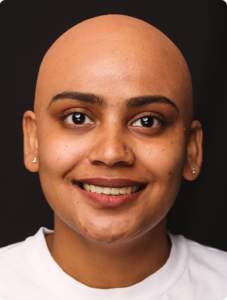Creating realistic burn effects is one of the most jaw-dropping and technically challenging skills in special effects makeup. From smoldering skin to layered tissue trauma, SFX burn makeup brings drama and believability to film, TV, theatre and even haunted attractions. But behind every convincing burn lies careful technique, the right materials and an understanding of anatomy and storytelling.
This blog will guide you through essential burn special effects makeup methods, tools and tips.
What Is SFX Burn Makeup?
SFX burn makeup is a specialized area of special effects makeup focused on recreating burn injuries, from light surface redness to deep, severe tissue damage. These effects are designed for screen, stage, cosplay and Halloween, helping to tell stories of survival, horror, or transformation.
Unlike regular makeup, this style often incorporates prosthetics, tissue buildup, latex, gel effects and complex color layering, all techniques that must be mastered with safety, precision and creativity.

Types of Burn Effects in SFX Makeup
Each degree of burn requires a different approach to makeup application. Here’s a breakdown:
1. First-Degree Burn
- Look: Redness, irritation, slight swelling.
- Technique: Use a red cream base or alcohol-activated paint, blended with slight yellow and pink tones. Apply a light amount of texture for a subtle effect.
2. Second-Degree Burn
- Look: Blistering, deeper redness, wetness.
- Technique: Layer gelatin, collodion, or latex to simulate raised blisters. Use a glossy finish to mimic moisture and carefully stipple color for realism.
3. Third-Degree Burn
- Look: Charred, blackened tissue, cracked skin.
- Technique: Sculpt or apply prosthetics with depth, using cotton and latex or silicone. Charcoal tones, dried blood and textured sponges are key here.
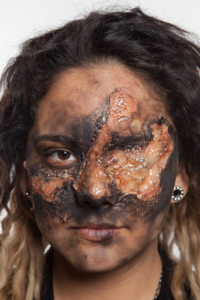
Understanding these levels is crucial for realism and for creating burn makeup that not only looks the part but supports the story being told.
Must-Have Tools & Materials for Burn Makeup
Creating realistic and impactful fake burn makeup requires more than just artistic flair, it demands the right tools, materials and a deep understanding of how to use them safely and effectively.
Key materials include liquid latex and cotton for creating texture, gelatin to form blisters, silicone for long-lasting prosthetics, rigid collodion to mimic scars, alcohol-activated paints for coloring and blood gels and pastes to simulate realistic wounds.
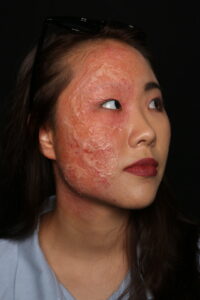
Here’s a breakdown of essential materials every aspiring SFX makeup artist should be familiar with:
1. Liquid Latex & Cotton
A time-tested, budget-friendly duo, liquid latex and cotton work together to create textured skin, peeling flesh and raised areas. By layering and sculpting with a spatula or fingers, you can build dimensional burns that hold color well and withstand movement.
2. Gelatin
Gelatin is a versatile material used to replicate soft blisters and bubbled skin. This material melts for easy skin application and can be sculpted before it hardens. It’s especially useful for second-degree burn effects due to its flexibility and translucency.
3. Silicone
For professional-level results, silicone offers a durable, reusable solution. It mimics the skin’s elasticity, making it ideal for high-end prosthetics. Silicone is commonly used to make reusable burn prosthetics that feature lifelike edges and textures, allowing them to blend naturally with the skin.
4. Rigid Collodion
Rigid collodion is excellent for creating sunken scars and puckered skin, perfect for simulating healed or older burn wounds. It works by contracting as it dries, pulling the skin inward for a natural indentation effect.
5. Alcohol-Activated Paints
These paints are a go-to choice for painting over textured surfaces like latex, gelatin, or silicone. Their waterproof nature and pigment strength make them ideal for layering colors such as deep reds, purples and burnt blacks to create hyper-realistic skin trauma.
6. Blood Gels & Pastes
Finishing with blood effects adds realism and intensity to your burn makeup look. Gels and pastes come in different viscosities and shades, from fresh arterial red to thick, darkened scabbing, to help tell the story of a recent injury or long-healed wound.
Quick Tip: Always test materials on the skin beforehand to prevent allergic reactions and work in a well-ventilated area. Understanding how different materials react to heat, light, and motion is essential to ensuring both safety and a realistic effect.
Check out our store for high-quality SFX products.
Step-by-Step: How to Create a Realistic Burn Makeup Look?
Creating realistic burn makeup involves careful layering of textures, color blending and detailed effects to mimic the appearance of skin trauma. This guide covers essential techniques to build convincing burns, whether blistered, charred, or scarred, helping you achieve authentic special effects makeup for any burn severity.
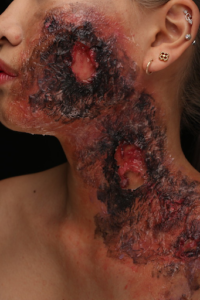
Step 1. Prep the Skin
Before applying any product, the skin must be clean, dry and free of oils. This ensures better adhesion and prevents discomfort for the model or actor.
- Clean the skin using witch hazel or a mild cleanser to prep the area.
- Apply a barrier spray or a thin layer of adhesive (like Pros-Aide) to protect the skin and enhance durability.
- If you’re working on a large area or for extended wear, consider using a bald cap or prosthetic base to minimize skin contact.
Step 2. Build Texture with Latex & Cotton
This is where the fake burn makeup starts to take shape.
- Apply liquid latex to the skin with a sponge or single-use applicator.
- Tear small pieces of cotton or tissue and layer them into the latex while it’s still wet.
- Sculpt the surface with a spatula, shaping wrinkles, ridges and broken skin textures that mimic damaged tissue.
- Let each layer dry before adding another to avoid clumping or sliding.
Pro Insight: Varying the height and shape of the latex build-up creates a more natural, chaotic burn pattern.
Step 3. Add Blisters with Gelatin
Second-degree burns are characterized by painful blisters. Use gelatin to replicate this critical element:
- Melt gelatin (usually in a microwave) until smooth and slightly warm.
- Carefully spoon or drip the gelatin onto the textured surface to form bulbous blisters or raised fluid-filled areas.
- Manipulate the edges with a spatula while it cools to shape them realistically.
You can layer multiple gelatin applications to create different blister depths and sizes.
Step 4. Paint the Trauma Base
Now it’s time to color the burn with depth and dimension using alcohol-activated paints or cream-based pigments.
- Begin with deep reds as the primary undertone – this represents inflammation and vascular damage.
- Blend in dark purples, burgundy and even hints of yellow to simulate bruising and infection.
- For the outer edges, soften the tones to blend into the natural skin, mimicking the way real burns fade.
Use sponges, stipple brushes, or even toothbrushes to create organic, broken patterns in the pigment.
Step 5. Add Detail & Depth
Small touches bring realism to your SFX makeup burns.
- Use a fine brush to paint broken veins, coagulated blood, or burned capillaries.
- Add rigid collodion in select areas to simulate puckered or tightened skin around healed zones.
- Lightly apply black or brown pigment near edges to suggest charring or older burn areas.
- For third-degree enhancements, darker gray or charred tissue textures may be used carefully.
Step 6. Simulate Oozing with Gloss
Nothing sells trauma like a realistic wet finish.
- Apply clear gel, glycerin, or FX gloss products to the burn site to simulate oozing wounds, sweat, or fluid from burst blisters.
- Concentrate gloss around the gelatin blisters or in crevices where fluid would naturally collect.
This creates an uncomfortable, visceral shine that heightens realism on camera.
Step 7. Set & Seal Your Work
Once you’re satisfied with the texture and paint, lock it in.
- Use a professional makeup setting spray to prevent smudging or running.
- For long shoots or performances, apply a layer of sealer or powder to reduce tackiness and increase wear time.
Pro Tip: Reference real burn images from medical sources to better understand wound depth, color transitions and healing stages. Always approach this research ethically and responsibly.
Creating authentic burn special effects makeup takes time and practice, but mastering these techniques can make your work stand out, whether you’re preparing for a film shoot, a haunted house, or a student showcase.
With the right tools, a trained eye and a commitment to detail, even beginners can start crafting show-stopping SFX burn looks that leave a lasting impact.
SFX Makeup Reads You Can’t Miss:
Foam Latex vs Silicone: Choosing the Right Material for SFX Prosthetics
What Do SFX Makeup Artists Use for Fake Blood?
How to Create Creature Design Using Latex, Silicone & Prosthetics?
Learn Special Effects Makeup at Cinema Makeup School
If you’re passionate about bringing lifelike injuries, creatures and cinematic illusions to life, there’s no better place to build your foundation than Cinema Makeup School. As part of Cinema Art College Corporation, a broader institution dedicated to creative education, we’re committed to nurturing the next generation of makeup artists.
Here, students go beyond theory, they train hands-on with industry-standard products, professional equipment and expert instructors who actively work in film, TV and live entertainment.
From SFX burn makeup and trauma simulation to full character transformation, our programs are designed to teach the craft at every level.
Take a look at our students’ incredible work!
Burn effects challenge every SFX makeup artist to think critically, sculpt creatively and paint with precision. With the right techniques and materials, you can transform any character with layers of texture, trauma and visual impact.
Keep pushing boundaries, study real-life references and refine your process; every burn you create adds to your storytelling power.
Creating a convincing bald look is a foundational skill in special effects makeup. Whether you’re transforming an actor for a dramatic role or crafting a Halloween creature, mastering bald cap application, especially using latex & vinyl, can take your character makeup to the next level.
This comprehensive guide explores how to apply a bald cap, the differences between latex and vinyl bald caps and tips to achieve realistic results.
Why Use Bald Caps in Character Makeup?
Bald caps are essential tools for makeup artists, allowing for quick transformation without shaving or major alterations. They’re commonly used in film, theater, cosplay and Halloween events to portray bald characters or to lay the foundation for prosthetic enhancements.
From horror villains to sci-fi creatures, bald cap makeup helps you create seamless, believable character looks. And with various materials available, such as latex and vinyl, you can tailor your application to fit performance needs, comfort and realism.
Vinyl vs Latex Bald Caps: What’s the Difference?
Before you learn how to apply a bald cap, it’s important to choose the right material:
- Latex Bald Cap: Made of thin, flexible latex, these caps are excellent for blending into the skin. They’re often used for more detailed or custom applications where edge work is crucial.
- Vinyl Bald Cap: Slightly thicker and smoother, vinyl caps offer durability and cleaner edges. They’re great for long wear and are easier to manipulate using acetone for a skin-like blend.
Check Out: How Cinema Makeup School’s SFX Makeup Course Brings Seasonal Characters to Life?
How to Properly Apply Vinyl & Latex Bald Caps for Character Makeup?
Applying a latex or vinyl bald cap involves precise steps for a natural, skin-like finish. This tutorial walks through prepping the scalp, trimming the cap, adhering and blending edges and painting for realistic character makeup – ideal for film, theatre, cosplay, or Halloween.
1. Prep the Hair and Skin
Start with clean, dry skin. Hair should be tightly pinned or braided flat to the scalp. Use a light coat of hair gel or pomade to keep flyaways down. Wipe down the face and hairline with alcohol or toner to remove oils and help the adhesive stick securely.
Pro Tip: Use a bald cap liner or wig cap under the bald cap for extra hold and hair protection.
2. Position and Trim the Cap
Place the bald cap over the head, aligning it with the natural hairline. Trim around the ears, nape and forehead with sharp scissors. Leave a bit of extra material along the edge to allow for blending.
Make sure the cap lies flat with no wrinkles. For vinyl caps, slightly heat the material with a blow dryer to make it more flexible if needed.
Beauty Buzz: How to get wrinkles out of a bald cap?
To remove wrinkles from a bald cap, gently warm it with a low-heat hair dryer, then stretch and smooth it using your fingers or a stipple sponge. Applying a thin layer of adhesive before positioning helps the cap lay flat. If folds remain, carefully adjust edges while the adhesive is tacky. Handle with care to avoid damage.
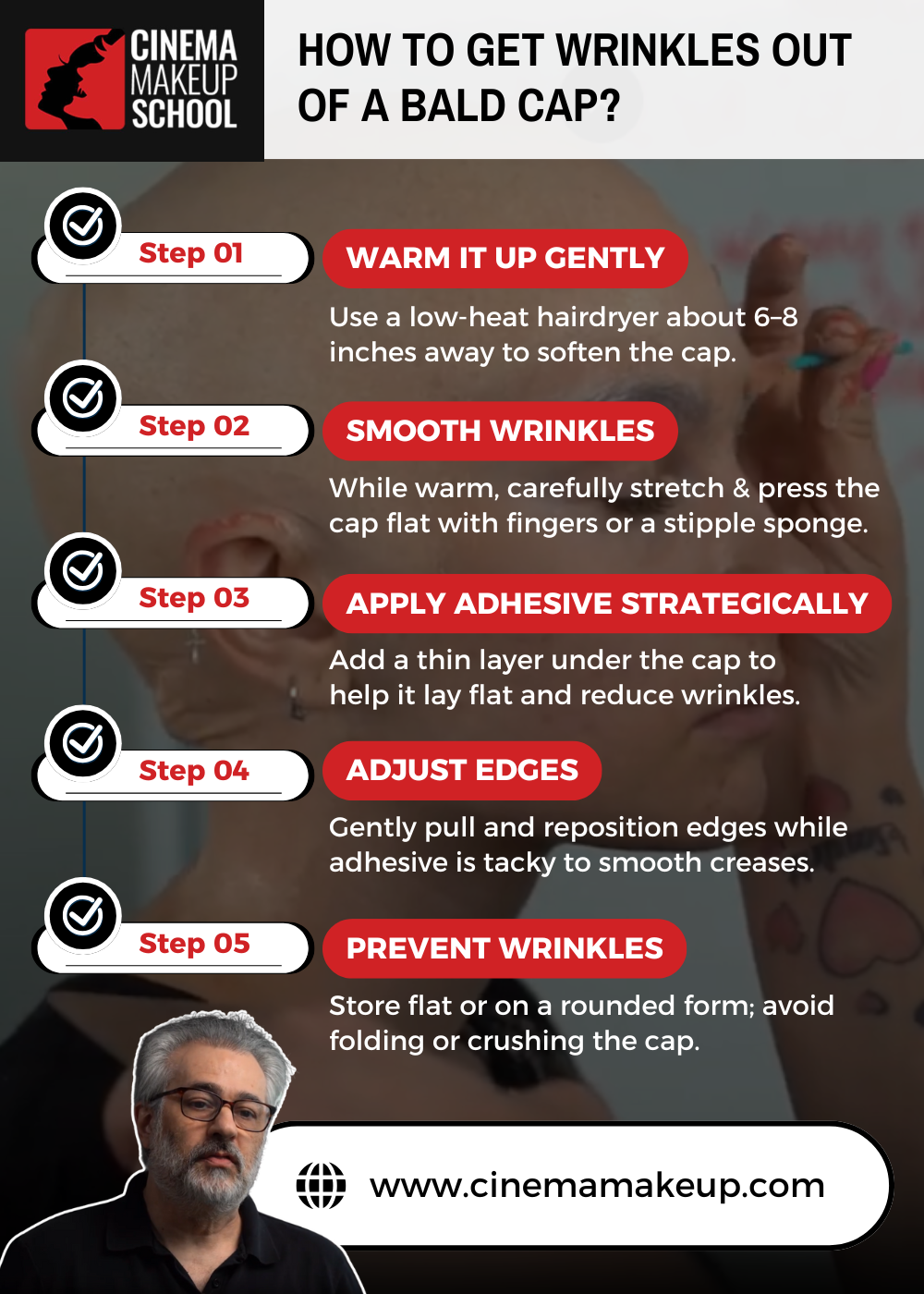
3. Adhere the Cap to the Skin
Apply a prosthetic adhesive (such as Pros-Aide or medical-grade adhesive) around the perimeter of the face. Press the edges of the cap into the glue, working in sections – starting at the forehead and moving to the sides and back.
Note: Vinyl bald caps stick best when the skin is free of oil, while latex caps may benefit from a light powdering before blending.
4. Blend the Edges
This is where the real magic happens in the bald cap application. Blending makes the cap look like real skin.
- For a latex bald cap, use liquid latex and a stipple sponge to feather the edge into the skin.
- For a vinyl bald cap, use acetone with a brush or sponge to carefully dissolve and melt the edges into the skin.
Take your time during this step. A smooth transition creates a more realistic appearance for your bald cap.
Note: If you need SFX makeup products to apply bald caps, visit our store.
5. Match Skin Tone and Paint
Learners often ask:
Can you paint a bald cap?
Absolutely – it’s a key step to achieving a lifelike look.
Use alcohol-activated palettes or rubber mask grease paints to match the cap to the actor’s skin tone. Lightly stipple on the paint using a sponge or brush, adding natural texture and color variation. If the character requires custom coloring, like blue for aliens or green for monsters, this is where you let your creativity shine.
6. Final Touches and Set
Set the makeup with translucent powder or a setting spray to reduce shine and help it last longer under hot lights or performance conditions. Add any additional elements like veins, bruising, scars, or grime to complete the look.
If you’re creating bald cap characters for a fantasy role or spooky Halloween costume, now’s the time to apply prosthetics, masks, or effects makeup over the cap.
Want to see it in action? Check out the character makeup tutorial here:
Learn Professional Bald Cap Application at Cinema Makeup School
In character makeup, transforming an actor into a completely different persona often begins with altering the appearance of the head. That’s where bald cap application plays a key role – it’s essential for creating convincing bald characters, aging effects, creatures and fantasy looks seen in film, television and stage productions.
As a division of Cinema Art College Corporation, Cinema Makeup School is dedicated to equipping you for this path. Our Special Effects Makeup Course offers hands-on training with both vinyl and latex bald caps, giving you the skills needed for real-world character work.
And bald caps are just the beginning. We’ll teach you how to turn makeup into movie magic. Enroll now and start creating your magic!
More Related Articles:
Essential Special Effects Techniques for Aging Makeup
How to Avoid Common SFX Makeup Mistakes?
What is the Difference Between Movie and Stage Makeup?
FAQs
Q: Are bald caps reusable?
A: No. Both latex and vinyl bald caps are generally single-use. Reuse can compromise the fit and finish, especially after stretching, blending, or painting.
Q: Can bald caps cover beards?
A: Yes, but it takes more skill. Using a bald cap for beard coverage involves flattening facial hair and using a combination of adhesives and prosthetic blending techniques to hide texture. Often, an additional prosthetic or stippled latex layer may be applied over the beard area for a smoother finish.
Q: Does the bald cap method protect your edges?
A: Yes, a properly applied bald cap protects your edges by creating a barrier between your hair and adhesives or makeup. Using a protective barrier before application and removing the cap gently helps prevent damage to your hairline.
Special effects makeuphas the power to transport audiences to new places, bring creatures to life and create stunning transformations that look incredibly real. If you’re passionate about creating these amazing effects, one of the most important decisions you’ll make is choosing the right material for your prosthetics.
Two of the most popular materials in the industry are foam latex and silicone, each with unique qualities that affect how your prosthetics look, feel and perform. Understanding the differences between these materials will give you the confidence to select the perfect material for your next project.
This guide is designed for artists at all skill levels who want to learn more about the strengths and challenges of these materials. You’ll find useful tips on making and applying prosthetics, so keep reading to find out which option suits your creative vision best.
What Are SFX Prosthetics?
Before diving into material comparisons, let’s clarify what SFX prosthetics are.
These are appliances created to alter an actor’s appearance. Prosthetics can simulate wounds, scars, aging, fantastical creatures, or completely transform someone into an alien or monster. They are sculpted, molded and then cast using materials like foam latex or silicone.
The material choice affects not only how the prosthetic looks but also how it moves, feels and lasts on camera or stage.
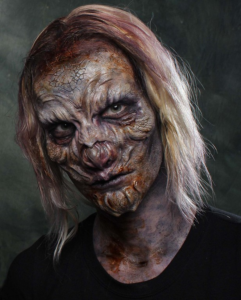
Foam Latex Prosthetics
Foam latex prosthetics have been a staple of special effects makeup for decades. Made by whipping latex into a foam and baking it in a mold, foam latex results in a lightweight, flexible material that is ideal for large prosthetic pieces.
Key Benefits of Foam Latex Prosthetics:
- Lightweight and breathable: Foam latex is porous, allowing air to pass through. This breathability helps actors remain comfortable during long shoots or performances.
- Flexible and stretchy: It moves naturally with facial expressions, making it ideal for creature masks and other large prosthetics.
- Cost-effective: Foam latex is generally less expensive than silicone, making it popular for productions with budget constraints.
- Easy to paint: It accepts paints and adhesives well, allowing for realistic finishes.
Smart Suggestion: Use KY Jelly to add realistic shine to foam latex appliances like tears or sweat for that extra lifelike touch.
Silicone Prosthetics
Silicone prosthetics have become increasingly popular, thanks to their camera-ready realism in today’s high-definition productions.
Advantages of Silicone Prosthetics:
- Unmatched realism: Silicone mimics the look and feel of real skin better than foam latex. It has a natural translucency and soft texture.
- Durability: Silicone is tougher and resists tearing better than foam latex, making it ideal for repeated use.
- Self-adhesive properties: Many silicone prosthetics bond directly to the skin without requiring additional glue.
- Water-resistant: Unlike foam latex, silicone prosthetics can withstand moisture and sweat without degrading.
Helpful Hint: Use 3rd Degree Silicone to achieve high-quality, skin-like prosthetics that hold up well over time.
Foam Latex vs Silicone
Let’s break down the unique strengths of foam latex and silicone in SFX makeup.
| Feature | Foam Latex | Silicone |
|---|---|---|
| Weight | Lightweight | Heavier |
| Flexibility | High | Moderate |
| Breathability | Very breathable | Not breathable |
| Realism | Moderate | High |
| Durability | Moderate | High |
| Cost | Lower | Higher |
| Application | Requires adhesives | Some are self-adhesive |
| Maintenance | Absorbs oils, requires care | More resistant to sweat and oils |
| Ideal Use | Large creature masks, theater | Close-up realistic wounds, facial appliances |
How to Make SFX Prosthetics: A Quick Overview
Making SFX prosthetics involves sculpting, molding, casting and painting to create lifelike pieces, followed by proper application techniques for a seamless finish. Here’s a quick breakdown of the essential steps involved:
- Sculpting: Start by sculpting the desired prosthetic shape using clay.
- Molding: Create a mold from the sculpture, usually in plaster or silicone.
- Casting: Fill your mold with foam latex or silicone and allow it to set fully.
- Demolding: Remove the finished prosthetic carefully.
- Painting: Use special paints designed for foam latex or silicone to bring your piece to life.
- Application: Attach the prosthetic to the actor’s skin using adhesives, blending edges for a seamless look.
Must-Read Articles on SFX Makeup:
How 3D Printed Prosthetics Are Revolutionizing Movie Makeup?
How Cinema Makeup School’s Bootcamps and Workshops Empower You to Master SFX Makeup?
How to Create Realistic Wounds and Scars with Prosthetics?
How to Apply SFX Prosthetics?
Application techniques can differ based on the prosthetic material:
Foam latex prosthetics require strong adhesives like pros-aide or spirit gum. Once applied, edges are carefully blended with liquid latex and makeup.
Silicone prosthetics often use medical-grade adhesives or are self-adhesive. Silicone paints or powders are used to match skin tones and add realism.
Insider Advice:
If you are wondering where to learn special effects makeup to create perfect prosthetics, look no further than Cinema Makeup School.
Here, you’ll learn from industry experts with hands-on experience in film, television and entertainment. As a proud part of the Cinema Art College Corporation, we’re committed to helping you develop real, career-ready skills.
We offer financing options to support your goals and make advanced education more accessible.
Our reputation continues to grow internationally. Learners from Korea’s MBC Academy Beauty School come to us for expert-level SFX training, showcasing our commitment to top-tier education
New to SFX Prosthetic Makeup? Start with These Expert Tips
- Start with foam latex prosthetic makeup if you are new to SFX prosthetics – it’s more forgiving and budget-friendly.
- Focus on sculpting anatomy and texture; a well-sculpted design is the foundation of a realistic prosthetic.
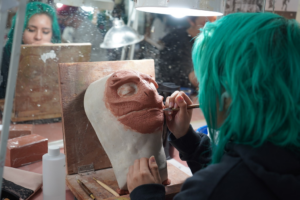
- Learn the casting process for both foam latex and silicone, as each requires different handling and curing techniques.
- Use material-specific paints – foam latex accepts PAX and alcohol-based paints; silicone needs silicone-based pigments.
- Master the art of seam blending to hide edges and make prosthetics look natural on the skin.
- Always prep the skin properly before applying prosthetics using the correct adhesives for each material.
- Clean and store prosthetics safely – foam latex needs dry, cool storage and silicone should be kept flat and dust-free.
- Build your starter kit gradually, investing in essential tools and products as your skills grow.
- Take photos of your work at every stage to track progress and build a portfolio.
- Watch professional tutorials and behind-the-scenes content to learn industry techniques and best practices.
- Be patient, practice regularly, accept mistakes and stay motivated to improve with each new piece.
Foam latex or silicone – each material has its own magic. Know your materials, master your craft and watch your SFX prosthetics come alive like never before!
Enroll today to take your passion for special effects makeup to the next level!
Prosthetic masks transform storytelling in film, television and live performances. From mythical creatures to aged characters and grotesque monsters, prosthetics allow MUAs to stretch the limits of imagination and bring fantastical visions to life.
If you’re an aspiring SFX makeup artist, understanding the craft of prosthetic mask creation and application is essential. This guide will introduce you to the core materials, techniques, & career pathways and how training at a professional school can set you apart in the industry.
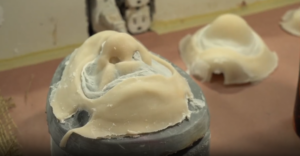
What Are Prosthetic Masks?
This is a specially designed facial appliance that changes the appearance of the wearer. It’s not just a costume piece; it’s a sculpted, hand-crafted extension of the actor’s face that integrates seamlessly with their expressions. These masks are used to create anything from realistic injuries to full-on creature features.
They come in various types:
- Foam latex prosthetic masks – Lightweight and breathable, ideal for extended wear.
- Silicone prosthetic masks – Known for their realistic texture and flexibility, often used for close-up shots. 3rd Degree Silicone is a favored choice for creating silicone masks that offer both flexibility and a lifelike appearance.
- Worth Noting: Each type of prosthetic material has its own strengths and ideal use cases, depending on the project’s budget, visual requirements and actor comfort.

How to Make a Prosthetic Mask?
Creating a prosthetic mask is a detailed process that combines life casting, sculpting, mold making, casting, painting and blending. Each step requires artistic skill and technical knowledge to bring characters to life realistically.
Here’s a simplified breakdown:
- Life Casting – The process starts by taking a mold of the actor’s face using alginate and plaster bandages. This creates a base on which the prosthetic will be sculpted.
- Sculpting the Design – Artists use clay to model the mask directly on the life cast, building the character’s features step by step. This step requires a strong understanding of anatomy and character design.
- Mold Making – A two-or three-part mold is created from the sculpted design. This mold is then used to produce the finished prosthetic.
- Casting the Prosthetic – Depending on the desired effect, artists use materials like foam latex, silicone, etc., to cast the mask. Each material requires different curing processes and handling.
- Painting and Detailing – Once cured, the prosthetic is painted using specialized pigments that work with the material’s surface. Fine details like veins, freckles, or texture are added here.
- Application and Blending – The final prosthetic is adhered to the actor’s face using medical-grade adhesives. Seamless blending with makeup ensures a natural and believable look.
See how our experienced MUAs create prosthetics:
General Query Answered:
How Do Facial Prosthetic Masks Help Individuals with Facial Differences Regain Confidence?
Prosthetic face masks can significantly enhance the emotional well-being of individuals with facial differences by restoring a sense of normalcy and helping them feel more confident in public and social settings. These prosthetics are carefully designed to match skin tone, texture and facial symmetry, allowing wearers to feel more comfortable in their appearance.
Beyond aesthetics, they can play a crucial role in improving mental health, reducing social anxiety and supporting a more positive self-image, especially after trauma, surgery, or congenital conditions.
How to Apply a Prosthetic Mask?
The application of a prosthetic mask is a step-by-step process that starts with skin preparation and adhesive selection. Edges are carefully blended to disappear into the skin, followed by precise color matching. Final effects like grime or sweat complete the transformation, making the prosthetic look lifelike.
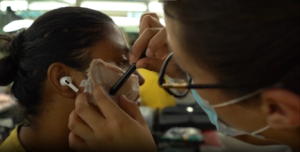
- Surface Prep: Clean and prep the skin with a barrier spray or toner.
- Adhesive Application: Use pros-aide, medical adhesive, or silicone-based glues depending on the material.
- Edge Blending: Thin edges are carefully blended with the skin using solvents like acetone (for foam latex) or isopropyl myristate (for silicone).
- Color Matching: The prosthetic is painted to match the actor’s skin tone and lighting conditions on set.
- Final Details: Blood, sweat, dirt, or environmental effects are added to complete the look.
Well! Just reading the process won’t magically create prosthetic masks – Hands-on training is crucial to mastering these skills, especially since materials react differently under studio lights and on different skin types.
And the most important question that arises here is: who provides the best SFX makeup course?
For countless successful SFX makeup artists, the journey started at Cinema Makeup School – a proud part of Cinema Art College Corporation.
What Makes Cinema Makeup School Unique in the SFX Makeup Industry?
Becoming a skilled prosthetic makeup artist isn’t something you learn from YouTube alone. It requires guided instruction, feedback and real-world experience.
Students at Cinema Makeup School gain more than just technical knowledge, they immerse themselves in an industry-level environment.
Take a look at what our students get access to:
- Mentorship from industry veterans
- Access to professional-grade labs and tools
- Opportunities to work on live sets and studio projects
- Career guidance for breaking into film and TV
- Support through financial aid options
This kind of immersive experience is what truly prepares aspiring artists for competitive work in Hollywood and beyond.
Pro Advice: Practice With Self-Sculpts
Before taking on big projects, practice by sculpting prosthetics for your own face. You’ll learn a ton about facial anatomy, symmetry and what works in terms of comfort and fit. Additionally, it makes for great content on your portfolio or social media to show your range and creativity.
Related SFX Makeup Guides:
How 3D Printed Prosthetics Are Revolutionizing Movie Makeup?
How to Create Realistic Wounds and Scars with Prosthetics?
How to Create Creature Design Using Latex, Silicone & Prosthetics?
Prosthetic masks are a powerful tool in special effects makeup, offering limitless possibilities to transform actors into incredible characters. From lifelike injuries to fantastical creatures, mastering the process of creating and applying these masks is essential for any aspiring SFX makeup artist.
With dedication, practice and the right training, you can unlock your full potential and make your mark in film and TV. The skills you develop in prosthetic mask-making will open doors to exciting opportunities, allowing you to bring imagination to life on screen.
There’s nothing quite like the impact of fake blood in special effects makeup. Whether you’re crafting a brutal zombie bite, a slashed throat, or a dripping vampire mouth, fake blood is often the final touch that brings your look to life-or-death.
But for SFX makeup artists, it’s not just about throwing red goo around. There’s real technique, science and strategy behind choosing the right kind of blood for the job.
Let’s talk about what goes into fake blood and why professionals take it so seriously.
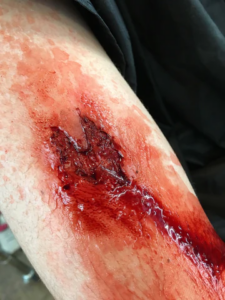
What Is Fake Blood Made Of?
Fake blood may look simple, but creating realistic effects takes a smart mix of ingredients. Whether you’re working on a film set or a DIY costume, most recipes rely on everyday kitchen staples to get the right color, thickness, and texture.
While at-home blends use things like corn syrup and food dye, professional products often add extras like glycerin or preservatives, or silicone pigments for better performance under lights and long wear.
Here’s what typically goes into fake blood, and why.
- Corn syrup – for that thick, sticky texture
- Red food coloring – the base color
- Blue or green coloring – adds depth and realism
- Chocolate syrup or cocoa powder – darkens the tone for dried or clotted blood
- Dish soap – helps with washability, especially on skin and costumes
Learn more – https://en.wikipedia.org/wiki/Theatrical_blood
Why Fake Blood Matters in Special Effects Makeup?
When you’re working in film, theater, or even haunted attractions, blood isn’t just a prop; it’s a storytelling tool. The color, consistency, placement and even the way it drips can tell the audience what happened, how it happened and how fresh the wound is.
Think about it: a thick, dark clotted wound tells a completely different story than a fresh arterial spray.
That’s why professional MUAs don’t rely on one type of fake blood. They have an arsenal and they know when and where to use each one.
Check Out: How to Create Realistic Wounds and Scars with Prosthetics?
Different Types of Fake Blood (and When to Use Them)
Not all fake blood is created equal and that’s a good thing. Depending on the look you’re going for, the lighting setup, or the actor’s skin, choosing the right type of blood can make or break the realism of your scene.
Here’s a deeper look at the 10 most commonly used fake blood types in SFX makeup, along with when and why you’d use each one:
1. Standard Runny Blood
This is your classic fake blood – liquid, smooth-flowing and versatile. It’s ideal for realistic bleeding effects like nosebleeds, paper cuts, or small wounds. Since it moves naturally, it’s commonly used for dripping or oozing effects down the face or body. Perfect for when you want blood that behaves like it would in real life.
2. Thick Blood
Thicker than your standard blood, this type has a syrupy consistency that makes it stick to wounds and stay put. SFX makeup artists often use it for deep cuts, stab wounds, or torn flesh because it gives the illusion of congealed, freshly spilled blood. It’s especially effective for high-impact horror shots or when layering over prosthetics.
3. Scab Blood
This one is all about texture. Scab blood is formulated to dry with a cracked, crusty surface, just like a healing wound. It’s used when you need to show older injuries, infected skin, or trauma that’s not fresh. It also adheres well to latex and silicone prosthetics without running off during long shoots.
4. Drying Blood
For productions where actors need to wear blood for hours without smudging or transfer, drying blood is essential. It sets within minutes and stays in place even under heat or sweat. Often used for background characters, live events, or multi-take scenes where you can’t keep reapplying fresh blood.
5. Edible / Mouth-Safe Blood
Made from food-grade ingredients like corn syrup and food coloring, this type is designed for safe use in and around the mouth. It’s crucial for vampire bites, internal bleeding scenes, or any situation where actors might accidentally ingest it. Some versions are even flavored to make them less unpleasant during takes.
Important Info: Some artists even mix food coloring with clear lubricants like KY Jelly to create realistic effects such as thick blood, slime, or mucus – perfect for mouth-safe scenes and glossy textures.

6. Non-Staining Blood
If you’re working with delicate fabrics, light skin tones, or expensive costumes, this is your go-to. Non-staining fake blood is formulated with less pigmented dyes and often includes detergent-like ingredients to allow for easier cleanup. It’s a smart choice for short-term shoots or when blood contact is unavoidable.
7. Spray Blood
Spray blood comes in pump or aerosol bottles for quick, even application across large surfaces. It’s often used in crime scenes, battle scenes, or environments that require a splatter or mist effect. Great for background props, walls, or quick blood bursts without needing a brush or applicator.
8. UV Glow Fake Blood
This blood reacts to blacklight, making it glow in eerie shades, perfect for haunted houses, neon horror scenes, or theatrical performances that need an otherworldly touch. UV Glow Fake Blood adds a supernatural flair and is often used in stylized productions, escape rooms and immersive horror events where visibility in the dark matters.
9. Cream or Gel Blood
This thicker, non-drippy version of fake blood is easy to control and apply with precision. It’s used frequently in stage plays and Halloween makeup because it stays in place, doesn’t transfer easily and doesn’t create a mess. Best for creating defined wounds, bloody noses, or bloodstains that won’t run.
10. Custom-Mixed FX Blood
Experienced SFX artists frequently develop custom fake blood mixtures tailored to specific lighting conditions, camera filters, or prosthetic materials, ensuring the blood appears natural and blends smoothly on screen.
These custom blends allow full control over color tone, thickness and reflectivity, crucial for ultra-realistic results in high-definition film and television. It’s the difference between amateur and pro-level work.
Knowing which type to use and when is what separates a hobbyist from a professional SFX makeup artist.
Get insights on: How To Become a Makeup Artist for Films?
Quick Query: Is Fake Blood Edible?
Short answer: Usually, no but depends on the ingredients.
It also depends on the formula. Edible or mouth-safe blood is typically made with food-grade ingredients, such as corn syrup, food dye and cocoa. These are safe if it accidentally gets in the mouth or if the scene calls for blood spitting, biting, or drooling.
But be careful – not all fake blood is safe to consume. Many pro products are not designed for ingestion and may contain chemicals. Always check the label.

Real-World Training in Fake Blood Application
If you’re serious about mastering fake bloody effects, you need hands-on training from professionals. That’s where Cinema Makeup School (CMS), which is part of a broader educational institution known as Cinema Art College Corporation, shines.
At CMS, students don’t just learn how to make fake blood, they learn how to use it realistically, effectively and safely. Our SFX makeup course covers everything from trauma simulation and prosthetic blending to on-set etiquette and HD camera prep.
You’ll work with industry-grade materials and create projects that look like they walked straight off a movie set.
Do you know?
Cinema Makeup School is ideal for students from many countries, as demonstrated by the visit from MBC Academy Beauty School in Korea to explore our Special Makeup Effects programs.
Watch the video here to see why we’re the top choice for aspiring artists worldwide:
How Do You Remove Fake Blood from Skin?
Removing fake blood requires gentle, effective methods to avoid skin irritation. Products like micellar water, coconut oil, soap, and toothpaste help break down pigments, while barrier sprays make cleanup easier. Avoid harsh chemicals, hot water, or scrubbing too hard, as they can worsen stains or damage skin.
- Makeup Remover or Micellar Water – For sensitive areas like the face or neck, these products gently remove fake blood without causing irritation.
- Coconut Oil or Baby Oil – When dealing with stubborn blood formulas, oils work wonders by breaking down the pigments, making cleanup much easier.
- Soap and Warm Water – Classic yet effective. A bar soap tends to remove fake blood better than body wash, especially when paired with warm water.
- Prep with Barrier Spray or Lotion – Protect your skin before applying fake blood. Using a barrier product makes it far easier to wipe off afterward.
- Toothpaste – Surprisingly, toothpaste can act as a mild abrasive and a cleanser for fake blood. Apply a small amount to the stain, scrub in circular motions and rinse with warm water.
- Lemon Juice – The acidity in lemon juice helps break down pigments while also serving as a natural disinfectant. It’s an excellent option for removing fake blood from skin.
What NOT to Do:
- Avoid Harsh Chemicals – Stay away from products that contain strong chemicals or alcohol, as these can dry out or irritate your skin.
- Don’t Scrub Too Hard – Over-scrubbing can lead to skin irritation, redness, or even abrasions. Be gentle to avoid damage.
- Don’t Use Hot Water – Hot water can cause the fake blood to set deeper into the skin, making it harder to remove. Stick to lukewarm water for the best results.
Worth Reading: How 3D-Printed Prosthetics Are Revolutionizing Movie Makeup?
Frequently Asked Questions:
1. How Long Does it Take for Fake Blood to Dry?
The drying time for fake blood depends on its type. Runny or edible blood tends to stay wet, which is great for creating active drips or a fresh, bleeding look. Drying blood or scab blood typically sets within 5 to 15 minutes, depending on air flow.
Gel or thick blood, however, may stay tacky for a longer period. To speed up the drying process, professional artists often use fans or heat tools on set. Just be sure to check if the product you’re using can safely handle additional heat or airflow.
2. Does Fake Blood Stain Skin?
It depends on the formula. Fake blood that doesn’t stain skin is specifically designed with gentle ingredients and added detergents.
Pro Tip: Always apply a barrier spray or lotion before using fake blood to help prevent staining and ease cleanup.
Every season sparks a different kind of magic, from the chilling haunt of Halloween to the shimmering wonder of winter festivals.
For special effects makeup artists, these times of year are more than just holidays; they’re opportunities to transform imagination into reality. Through paint, prosthetics and pure creative vision, artists craft characters that capture the season’s spirit.
Creepy creatures, frosty witches, mischievous trolls – each character tells a story that audiences instantly connect with.
Let’s take a closer look at some of the stunning seasonal creations made possible through the power of special effects makeup.
Cinema Makeup School: Where Imagination Becomes Reality
Cinema Makeup School, a proud part of the Cinema Art College Corporation, empowers students to master the magic of transformation, not just learn makeup techniques.
Through our SFX Makeup Course, artists are trained to create creatures, monsters and characters that captivate audiences across film, TV, streaming and theater.
From sculpting and prosthetics to painting and full-body fabrication, students transform fantasy into breathtaking reality, with seasonal characters providing the perfect playground to showcase their skills.
Let’s explore how our talented artists bring unforgettable seasonal figures to life.
Check Out: How To Become a Makeup Artist for Films?
Inside the SFX Makeup Program
Cinema Makeup School’s special effects makeup curriculum combines hands-on learning, industry mentorship and professional tools.
Students train on everything from:
- Life casting
- Mold making
- Prosthetic sculpting
- Foam latex and silicone work
- Hair punching and wig making
- Airbrush mastery
- Creature design for HD and 4K cameras
This isn’t just classroom learning, it’s production-level work, preparing students for real-world Hollywood careers.
Now, let’s meet the incredible characters our students have created using these skills.
Get insights on: How to Create Realistic Wounds and Scars with Prosthetics?
Seasonal SFX Creations by Our Talented SFX Makeup Artists
1. Halloween: The Haunting Spectacle
Halloween is a time when the spooky and the supernatural come alive. Thanks to the expertise learned at Cinema Makeup School, our students have created everything from sinister clowns to terrifying spirits. With prosthetics and makeup that ooze eerie details, Halloween characters transform into creatures of legend, sparking both fear and fascination.

2. Autumn: The Mysterious Harvest Creatures
As the leaves turn and the air chills, autumn invites a unique blend of mystery and magic. Our artists bring to life enchanted forest dwellers, with makeup that merges earthy tones with otherworldly elements. From witches riding through the crisp air to creatures lurking beneath the harvest moon, these characters tap into the seasonal magic that autumn brings.
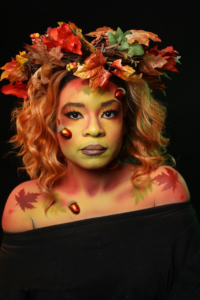
3. Winter: The Frostbitten Fantasies
Winter isn’t just cold; it’s magical. From frosty ice queens to snow-covered beings of myth, winter characters are created with delicate layers of makeup and prosthetics that embody the season’s serene beauty and its chilling allure. Our students bring these cold yet captivating figures to life, capturing the essence of winter in every brushstroke.

4. Christmas: The Merry Magic
Christmas is a celebration of warmth and joy and our SFX makeup artists bring the season’s characters to life with a touch of magic. From mischievous elves and regal Santa Clauses to magical reindeer and festive fairies, these holiday figures leap from the imagination into the real world, each one more vibrant than the last.
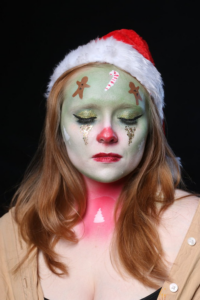
5. Themed Parties: The Mythical Menagerie
For themed parties, special effects makeup takes on a whole new level of creativity, turning ordinary animals into fantastical characters. From vibrant peacocks with feathered plumage that rivals the grandest of festivals to lions with glowing eyes that exude regal strength, the possibilities are endless.
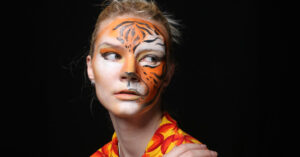
Learn How to Create Creature Design Using Latex, Silicone & Prosthetics?
Other SFX Characters to Admire
-
Gothic Vampire: The Dark Elegance
There’s a timeless allure to the gothic vampire, blending sensuality with danger. Our students have mastered the art of creating these nocturnal creatures, from their blood-red eyes to their pale, flawless skin. With intricate prosthetics and airbrush techniques, they craft vampires that are both hauntingly beautiful and terrifying in equal measure.

-
Spider Queen Calavera: The Creepy Majesty
A blend of gothic and gothic fantasy, the Spider Queen Calavera is an embodiment of both eerie elegance and fearsome power. With intricate designs inspired by both spider webs and skull motifs, our artists have brought this formidable queen to life, with dark, striking features and surreal elements that captivate the viewer. This character is not only a work of art but a triumph of creativity.
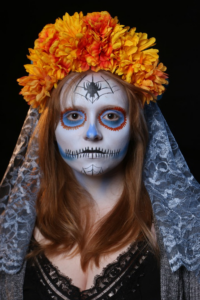
-
Cosplay Character
Cosplay characters are a standout in the realm of SFX makeup, turning fans into their favorite fictional characters. Whether for conventions, photoshoots, or live performances, cosplay allows individuals to fully embody the characters they admire. With the help of special effects makeup, cosplayers bring their characters to life with realistic prosthetics, airbrushing and body painting techniques.
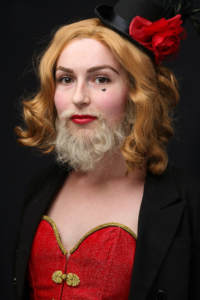
Apply now to join our SFX Makeup Course!
People Also Ask:
1. How do special effects makeup artists create monsters?
Special effects makeup artists create monsters by first designing the creature and sculpting prosthetics, which are then molded and cast in materials like latex or silicone. These prosthetics are applied to the actor’s skin, blended seamlessly and painted with airbrushes and makeup to add realistic textures and details. For additional features like hair or teeth, artists may incorporate wigs or custom dental pieces.
You can watch a step-by-step tutorial on how monsters are created here.
2. How long does it take to learn special effects makeup?
Learning special effects makeup can vary in time depending on the program. For example, our comprehensive training ranges from short workshops to full-fledged SFX makeup courses lasting several months. Aspiring makeup artists often begin with foundational skills and work up to advanced techniques like creature design and prosthetics.
3. How do special effects makeup artists work with filmmakers?
Special effects makeup artists work alongside filmmakers to craft characters that bring the director’s vision to life. They provide custom makeup and prosthetics for each character, ensuring that the designs complement the storyline and visual aesthetics.
The artist also works within production schedules to ensure makeup is completed on time and suits the lighting and camera angles of the scene.
4. Can the SFX skills learned be applied to creating characters for other seasons and holidays?
Absolutely! While the blog focuses on autumn, winter and Christmas season creations, the techniques you learn are versatile and can be applied to characters for any time of year. No matter if you’re creating spooky monsters for Halloween or vibrant creatures for spring, the skills are adaptable to various themes.
Every makeup artist starts somewhere – maybe it was Halloween, cosplay, or an obsession with movie monsters. But for those of us who want more than just Instagram likes, those who want to become pro MUAs, one skill separates the average artist from the unforgettable: SFX makeup.
SFX makeup looks aren’t just cool, they’re challenging, creative and insanely powerful. They allow you to tell stories, create characters and bring wild imaginations to life. From blood and bruises to mythical beings and anime icons, the range is endless.
And if you’re dreaming of working in film, TV, theater, or conventions like Comic-Con and DragCon, mastering special effects makeup is non-negotiable.
Let’s go through a guide covering a range of must-know SFX makeup looks for MUA in training.
Must-Know SFX Makeup Looks for Building Your Pro MUA Portfolio
1. Monster Makeup Look: Your First Real Test
Creating monsters isn’t just a rite of passage; it’s a crash course in the fundamentals of SFX makeup. Working on monster looks helps you master prosthetics, latex application, 3D effects and the art of realistic gore.

Why It Matters:
- Teaches texture, layering and balance
- A must-have for horror and sci-fi work
- Great practice for building out full-face prosthetics
Example Practice: Create a half-human, half-creature transformation using silicone or latex prosthetics, fake skin and paint. Think about why the transformation happened – was it caused by a mutation, magic, or something else? This will help guide your design choices and make your look more creative and unique.
Where You’ll Use It: Horror films, haunted attractions, music videos, indie film sets.
Watch Julia Melnik’s Journey at Monsterpalooza:
2. Halloween Makeup Looks: The Perfect Blend of Glam and Gore
Halloween looks bring a surge in demand for SFX makeup, providing the perfect opportunity to showcase your skills and creativity.
Why You Should Master Halloween Looks:
- Increased Demand: Clients are always on the lookout for makeup artists who can pull off both spooky effects and high-impact style.
- Versatility in Design: Halloween looks allow you to experiment with combining beauty and horror, offering endless possibilities for creating both glamorous and eerie effects.
- Boost Your Portfolio: Halloween looks are perfect additions to your portfolio, showcasing your creativity and skill. These unique, high-impact designs help attract future clients and expand your professional opportunities.
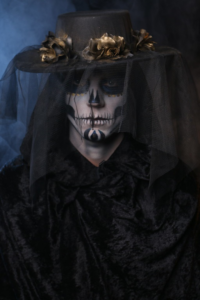
What You’ll Learn:
- Mixing Beauty with Blood: Learn how to balance glamour with gore, creating looks that are both stunning and chilling. Learn how to balance glamour with gore, creating looks that are both stunning and chilling.
- Creative Adaptability: Halloween brings a wide variety of client requests. You’ll learn how to adjust your skills to fit different Halloween themes, whether it’s spooky, whimsical, or horror-inspired.
Popular Halloween Styles to Try:
- Glam zombies
- Stitched-up dolls
- Vampires
- Witches
- Sugar skulls
Pro Tip: Mastering Halloween looks can lead to steady gig opportunities. Many people book makeup artists for private parties, events, or haunted houses, giving you a chance to expand your network and build a reputation in your local community. Word of mouth from a standout Halloween look can lead to year-round clients.
3. Anime Makeup Transformations: Mastering Detail and Design
Anime SFX makeup is booming, especially in cosplay circles. These looks require a steady hand and an eye for detail. From over-the-top eyes to dramatic scars and unique facial shapes, you’ll build precision, color mastery and creativity.

Why You Can’t Skip This:
- Guides you in enhancing features without disrupting facial balance
- Requires mastery of color correction and contouring
- Helps you prep for conventions like Anime Expo or fan meetups
Creative Task: Design an anime-inspired character using body paint, detailed shading and silicone elements to bring your vision to life.
4. Circus Makeup Looks: Bold, Bizarre and Full of Character
Want to blend artistry with eccentricity? Circus-inspired looks offer endless creative possibilities, think evil clowns, tattooed ladies, fire-breathers and illusionists. These transformations are all about pushing the boundaries of design and performance, creating bold, striking looks that leave a lasting impression.
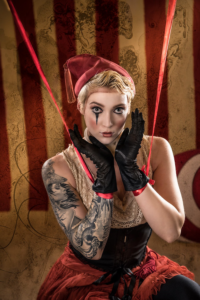
Skill Set Unlocked:
- Learn how to make features like big eyes, sharp cheekbones, or dramatic facial shapes – perfect for characters like clowns or acrobats.
- Find out how to combine prosthetics (like fake noses or scars) with body paint to create eye-catching looks, such as tattooed performers or unique circus characters.
- Circus looks often have fun, uneven shapes or exaggerated features, like a very wide smile or a twisted face, to make the character stand out.
- Learn how to make ordinary things look strange, like turning a performer’s body into something artistic, or making designs that trick the eye.
Try This: A cracked porcelain clown with tear-away skin, blacked-out teeth and creepy contact lenses.
5. Religious & Mythical Characters: Symbolism Meets Technique
Creating angels, demons, saints, or mythical gods pushes your storytelling and creative thinking. These makeup designs often feature elements like metallic finishes, feathers, light effects, or custom-made horns crafted by hand.

Key Skills to Master:
- Symbolic Detailing: Learn to use symbols and textures (like gold, stone, or glowing effects) to add deeper meaning to your characters.
- Advanced Textures: Master creating textures like cracked skin, molten gold, or glowing wounds for more dynamic and realistic looks.
- Prosthetics and Sculpting: Perfect the art of sculpting prosthetics, such as horns, wings, or intricate features to transform your character.
- Lighting and Special Effects: Integrate effects like LED lights or smoke to enhance the supernatural or divine feel of your design.
- Expressing Emotion: Use makeup to evoke emotions, whether it’s the serenity of a celestial being or the power of a mythical god.
6. Drag Makeup Looks: Where Drama and SFX Collide
Drag makeup is a form of self-expression that pushes the boundaries of beauty and creativity. When combined with SFX, drag makeup becomes a powerful tool for extreme transformations and show-stopping looks. These looks often go beyond traditional beauty makeup, incorporating elements like prosthetics, body paint and bold effects that turn a look into a true work of art.
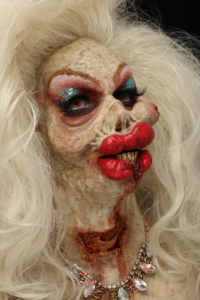
Iconic Drag Makeup Looks to Try:
- Glamorous Queen
- Alien/Space-Inspired
- Gothic Queen
- Fantasy Characters (Mermaids, Fairies, Gods)
- Clown Drag
- Tattooed Queen
- Futuristic/Robot Drag
Key Skills to Master:
- Gain hands-on experience applying prosthetics to craft bold features—like oversized lips, extra eyes, or horns – using materials such as latex, silicone, or foam.
- Master the art of full-body painting to transform the skin into a canvas – think metallic finishes, intricate patterns or vibrant tattoos.
- Perfect the use of bold contouring and strategic highlighting to sculpt and exaggerate features, adding depth and drama to the face.
- Develop skills in using makeup to sculpt the face and body, producing bold 3D effects that enhance drag character transformations.
- Learn how to seamlessly integrate SFX elements like glowing details, cybernetic enhancements and body modifications into your drag makeup looks.
7. Comic-Con Inspired Makeup Looks: Cosplay Goes Cinematic
Comic-Con makeup challenges you to transform models into lifelike characters using advanced SFX techniques. From superheroes and villains to fantasy warriors and sci-fi creatures, each look pushes your creativity and technical skills to the limit.
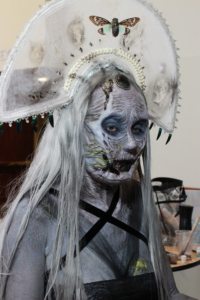
Pro Skillsets You’ll Build:
- Creating custom prosthetics tailored to characters like superheroes, villains and mythical creatures.
- Using scar wax and latex for comic-accurate wounds and facial structures
- Applying weathered effects like dirt, blood, burns, or cracked armor
- Creating long-wear looks suitable for full convention days
- Painting realistic skin textures like scales, fur, or alien patterns
- Integrating makeup smoothly with helmets, masks and other costume elements
- Matching colors and details to replicate animated, game, or movie characters
Watch KC Mussman’s “Clicker” for Comic-Con Makeup Inspiration –
8. Fantasy Makeup for WonderCon: Ethereal & Detailed
Fantasy makeup seen at conventions like WonderCon showcases the artistic side of SFX. From mystical elves and fairies to cosmic beings and magical royalty, these looks highlight creativity, imagination and fine detail. These looks incorporate sculpted prosthetics, layered paints and intricate details to craft one-of-a-kind characters.

What Makes Fantasy Makeup Special:
- Designing original fantasy characters like elves, fairies or celestial beings
- Sculpting soft prosthetics such as ears, horns or delicate facial features
- Using color theory for dreamy, magical blends (think pastels, shimmer, glow)
- Applying detailed body paint to mimic skin textures, armor, or nature elements
- Layering accessories like face jewels, feathers, or floral accents
- Blending beauty makeup with SFX for graceful, otherworldly results
- Creating cohesive head-to-toe fantasy transformations for cosplay settings
Try This Look: Design a forest-inspired elf queen using hand-sculpted ears, iridescent body paint, natural elements like leaves or moss and face jewels for an enchanting finish.
Why Do These SFX Makeup Looks Matter for Your Career?
Experimenting with these SFX makeup looks is more than just an enjoyable challenge, it’s a strategic step in advancing your career as an SFX makeup artist. Each look introduces new techniques that will sharpen your skills in special effects makeup, from detailed prosthetics to creative storytelling.
As you develop your craft, mastering these diverse styles will set you apart in the industry. They offer valuable experience in everything from body painting and character design to cosplay artistry.
Start Your SFX Makeup Journey with Cinema Makeup School
If you’re ready to take your skills to the next level, consider joining Cinema Makeup School, which is part of the broader educational institution known as Cinema Art College Corporation.
Our comprehensive courses are designed to teach you everything from basic techniques to advanced special effects. You’ll learn from industry professionals and gain hands-on experience with the tools and materials used by top artists in film, television and live events.
Take the next step in your career and explore how you can create amazing SFX makeup looks that will help you stand out in the special effects makeup industry.
Recommended Reads:
How to Create Creature Design Using Latex, Silicone & Prosthetics?
How 3D Printed Prosthetics Are Revolutionizing Movie Makeup?
How Cinema Makeup School’s Bootcamps and Workshops Empower You to Master SFX Makeup?
Mastering these 8 special effects makeup looks will sharpen your skills and elevate your career as a makeup artist. Each look teaches unique techniques, helping you build a strong portfolio for opportunities in film, TV and conventions. Keep experimenting – your creative potential is limitless.
Ever wondered how those jaw-dropping creatures from your favorite sci-fi or horror films are brought to life? Well, it’s not magic; it’s the art of Special Effects Makeup, where masterful creature design meets hands-on technique using materials like latex, silicone and detailed prosthetics.
Behind every snarling beast, ancient alien, or mythical monster is a skilled SFX artist who knows how to fuse creativity with material science. Dreaming of designing creatures that look like they walked straight off a movie set?
Let’s pull back the curtain on creature creation and show you how it’s done.

Crafting Creatures: Transforming Concepts into Reality
Creating a believable creature isn’t just about wild imagination, it’s about bringing it to life with physical and digital artistry.
In the makeup and film industry, creature design involves a fusion of sculpting, painting, prosthetics application and, increasingly, digital enhancement. And the secret weapons? Latex, silicone and prosthetics.
These materials offer the flexibility, texture and realism required to transform actors into otherworldly beings – whether for big-screen blockbusters, haunted attractions, or gaming promos.
But how exactly do you go from idea to full-blown beast?
Check Out: How to Create Realistic Wounds and Scars with Prosthetics?
How to Design a Creature Using Latex, Silicone & Prosthetics?
Step 1: Creature Concept & Design Sketch
Before you touch any material, you need a concept. Start with rough sketches of your creature. Think about:
- Backstory: Where does it live? What does it eat? What’s its purpose?
- Anatomy: Is it humanoid? Insect-like? Hybrid?
- Silhouette: Strong shapes help make creatures memorable.
This is your blueprint. Most makeup artists start digitally with tools like Photoshop or Procreate to refine ideas quickly.
Step 2: Sculpting the Creature Maquette
Once the concept is approved, it’s time to sculpt a creature maquette – a scale model that brings your 2D concept into 3D form.
Materials & Tools:
- Chavant NSP clay for sculpting
- Wire armature for structure
- Loop tools and rakes for shaping
This is where you build the form, define muscles and add textures like scales, skin folds, horns, etc.
Tips:
- Focus on dynamic poses
- Balance realism with creativity
- Studied animal anatomy for reference
Step 3: Mold Making & Casting
Now that the sculpture is complete, you’ll create a mold around it – this is how your final latex or silicone pieces will be shaped.
For Latex:
- Mold is made with plaster or stone
- Liquid latex is poured in, slushed and left to dry
- Ideal for flexible, lightweight masks or skin
For Silicone:
- Use platinum-cure silicone for realistic skin texture
- Requires precise mixing and professional-grade molds
- Results in durable, flesh-like prosthetics
Comparison Tip:
- Latex = lightweight, budget-friendly, great for big builds
- Silicone = hyper-realistic, skin-like and great for close-up shots
Step 4: Prosthetic Application
This is where the creature comes to life on the actor.
Steps:
- Clean and prep the actor’s skin
- Apply adhesives (like Pros-Aide or Telesis)
- Blending edges using alcohol or blending tools
- Paint using PAX paints, alcohol-based colors, or airbrush
- Add final textures, blood, dirt, or shine
Silicone prosthetics feel real and move with the actor’s expressions, while latex pieces are more suited for larger costume sections.
Step 5: Final Touches & Camera-Ready Finish
Once the prosthetic is applied:
- Improve your creation with hair punching, add detailed veining, or achieve a glossy finish using glycerin.
- Use contacts and dentures for realism
- Test under lights and camera to ensure everything reads well
Why Latex, Silicone and Prosthetics?
- Latex Creature Builds: Liquid latex is flexible, lightweight and ideal for creating skin textures, wounds, or adding layered detail to your character. It’s a go-to for fantasy creatures that require stretch and movement.
- Silicone-Based Creatures: Silicone offers a more skin-like, translucent finish. It’s heavier, more durable and perfect for creating realistic, fleshy appearances – think aliens or mutated humans with intricate facial structures.
- Prosthetics: These are the game-changers. Prosthetics help modify the actor’s appearance – elongate noses, change cheekbones, add horns or gills, while keeping the look believable on camera.
Together, these elements make creature characters not only visually powerful but also performance-ready.
Want to see the creature design process in action? Watch the full tutorial on YouTube –
Where to Learn the Art of Creature Design?
If this creative journey excites you, then professional training is your next step. Cinema Makeup School, which is part of the broader educational institution known as Cinema Art College Corporation, offers one of the most immersive and industry-relevant programs in Special Effects Makeup – Creature Concept Design Program.
This three-week intensive (120 clock hours) combines both digital and physical creature design, giving students a full-spectrum experience from concept art to sculpted maquettes.
Here’s a breakdown of the key learning outcomes from this program:
1. Digital FX Makeup
In this track, students learn how to design a creature concept that looks camera-ready. The program covers topics such as photo retouching, concept art development and using tools like Photoshop while working with a Wacom tablet to bring the ideas to life.
Skills and techniques covered:
- Working with a Wacom drawing tablet
- Photoshop portrait retouching
- Concept art development and quick turnaround concept creation
- Collaging layers and overlaying textures
- Image manipulation and recoloring
- Photo manipulation and more
2. Creature Maquette Sculpting
Bring your creature to life! This part of the program introduces clay sculpting and armature building, teaching you how to physically model your concept.
Core skills developed in this track include:
- Concept artistry and constructing an armature
- Working with Chavant NSP clay
- Sculpting anatomical details
- Adding creature features like scales, horns and other unique traits
- Stylizing hair, layering clothing and adding texture
- Building expressive, dynamic poses

3. ZBrush Digital Design
Take your physical sculpting into the digital space. With ZBrush, students learn to digitally sculpt detailed busts of characters, complete with accessories, hair and textured finishes.
Skills built in this track include:
- Digital sculpting using a Wacom tablet
- Mastering ZBrush tools and subtools
- Working with geometry and mesh control
- Polypainting techniques for adding color and detail
- Hair brushing and refining fine features
- Surface finishing for professional-grade digital models
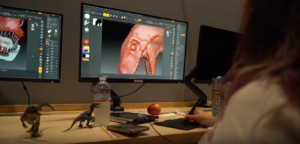
Get Inspired with More Reads:
How Cinema Makeup School’s Bootcamps and Workshops Empower You to Master SFX Makeup?
How Hard Is It to Learn Airbrushing?
SFX vs Prosthetic Makeup: What is the Difference?
Sculpt the Unseen, Design the Unbelievable!
Creature design is where imagination meets precision – an exhilarating mix of storytelling, sculpting, digital artistry and prosthetic magic. If you’re dreaming up a terrifying alien or a mythical beast, understanding the materials and techniques behind latex, silicone and prosthetics is key to turning those visions into reality.
With the right training, tools and creative mindset, you can step into special effects makeup and begin crafting creatures that captivate, terrify and inspire. The journey from sketch to screen begins with one decision: to start.
When it comes to transforming an actor into a character of a different age, special effects makeup (SFX makeup) is the magic behind the scenes. Aging makeup isn’t just about adding wrinkles – it’s a meticulous process that brings old age to life.
Whether you’re working on a movie set, a TV show, or a theater production, understanding the essential SFX techniques for aging effects will give your characters a believable and realistic appearance.
In this blog, we’ll discuss these techniques, explain how they work and show you how to create stunning aging transformations.
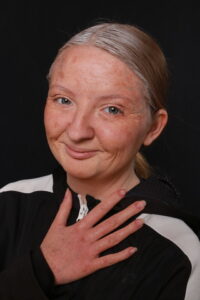
Aging Makeup: Must-Know Special Effects Techniques
1. Preparing the Canvas: Skin Care and Preparation
First, it’s important to start with a clean, moisturized base. Aging makeup often involves layering products on top of the skin, so it’s essential to hydrate and prep the skin. Apply a moisturizer to create a smooth surface for your makeup application. If the skin isn’t prepped correctly, the makeup may not adhere well, leading to an uneven finish.
Quick Tip: Use a primer designed for aging skin to create an ideal canvas. This ensures that the makeup lasts longer and stays fresh throughout the shoot.
2. The Power of Age Spots and Liver Spots
To take old age makeup to the next level, you can’t forget the power of age spots and liver spots. These give your character the authenticity of someone who’s lived a full life.
Use SFX makeup products like special effects pigments, face paints, or even powdered eyeshadows in darker shades to mimic the uneven pigmentation of age spots. Blend these carefully, focusing on the areas where aging spots most often appear, like the forehead, hands and cheeks.
Helpful Hint: Don’t overdo it. Adding a few small details in the right places can make your character look older, but it won’t look too fake or exaggerated.
3. Shading and Highlighting
Shading and highlighting are key to creating depth in aging makeup. As people age, their skin naturally loses volume and certain areas, like the cheeks, temples and under the eyes, sink in. To mimic this, you’ll need to use contouring techniques to create the illusion of hollowed-out areas. Use darker shades for shadowing and lighter shades for highlighting the high points of the face.
Insider Advice: Apply a lighter foundation or highlighter to the high points of the face to emphasize areas that still maintain prominence with age.
4. Eyes and Lips: The Telltale Signs of Age
Aging isn’t just about the skin. The eyes and lips tell a story, too. As we age, the skin around the eyes becomes looser and the lips lose volume. You can create this illusion with special effects makeup by lightly darkening the under-eye area to mimic shadows from drooping skin. Use a lip liner to enhance the natural shape of the lips and then apply lipstick in a more muted, less vibrant color to recreate the fading of lip color with age.
Expert Insight: Avoid making the lips too dark, as this can make the aging effect look overdone. A subtle color goes a long way.
5. Creating the Look of Thin, Frail Skin with Translucent Powders
As we age, skin becomes thinner and veins become more visible. To create this effect, you can use translucent powders to set your makeup, giving it a lighter, more delicate finish. For even more realism, apply a light wash of blue or greenish makeup around the temples and under the eyes to mimic the appearance of veins showing through thinning skin.
Pro-Level Advice: Use a fine, translucent setting powder to lock your aging makeup in place without making the skin look cakey or unnatural.
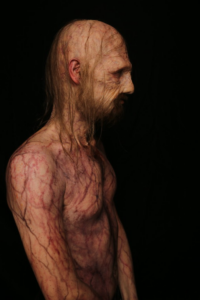
6. Hair Color and Texture: Don’t Forget the Grays!
While makeup can create the illusion of old skin, you can’t forget about the hair. No matter if you’re working with a wig or applying temporary color to natural hair, graying or thinning hair can dramatically change a character’s appearance. Use a mixture of white, gray and silver hair color sprays to add that silver sheen. For thinning hair, use a texturizing powder or even a special effects hair product designed to create the illusion of balding or receding hairlines.
Must-Know Technique: Use a root touch-up spray for an easy way to mimic gray hair along the hairline or temples.
7. Using Silicone Prosthetics for Aging Effects in SFX Makeup
Silicone prosthetics are a game-changer when it comes to aging makeup in special effects (SFX). Unlike latex, silicone is more flexible and breathable, making it ideal for creating realistic aging effects that move naturally with the skin. From wrinkled brows, crow’s feet to sagging jowls, silicone prosthetics can give a truly lifelike appearance.
Creative Development Tip: Always remember to use prosthetic adhesive designed for silicone when applying these pieces and be sure to blend the edges seamlessly into the skin to avoid visible lines.
Creative Suggestion: How to Create Realistic Wounds and Scars with Prosthetics?
8. Finishing Touches: Setting the Aging Makeup
Once you’ve applied all your aging techniques, it’s crucial to lock everything in place. Since special effects makeup often involves multiple layers and products, using a setting spray specifically formulated for SFX makeup will help keep your look intact all day.
Pro Tip: Always set your makeup with a fine mist of setting spray to prevent cracking or fading throughout the day.
To enhance your aging makeup skills, check out our YouTube tutorial on SFX and prosthetics –
It’s a great way to explore advanced techniques that can elevate your aging effects.
Role of Aging Makeup in Different Genres: Horror, Fantasy and Drama
Aging makeup isn’t just about creating realistic portrayals of old age. It plays a crucial role in enhancing characters across different genres, adding depth and dimension to your storytelling. Here’s how old age makeup impacts various film genres:
Horror: Old-age makeup is used to transform characters into terrifying ancient creatures, monstrous elders, or other unsettling figures. In horror films, the aging effect can amplify a character’s sinister or eerie presence, making them more menacing.
- Example: Use exaggerated wrinkles, deep-set eyes and dramatic sagging skin to create a sense of fear or horror in a character.
Fantasy: In fantasy genres, aging can portray timeless characters like wizards, immortals, or ancient beings who have lived for centuries. The goal is to suggest wisdom and experience without transforming too harshly.
- Example: Apply subtle aging effects like crow’s feet, gray hair and gentle lines to portray the wisdom that comes with age in a fantastical setting.
Drama: In dramas, aging effects contribute to the realism of a character’s life journey. The subtle transformation showcases the passage of time and life experiences, making characters more relatable and believable.
- Example: Use natural aging techniques such as light wrinkles, slightly hollowed cheeks and subtle skin texture changes to convey the passage of time.
Pro Tip: Adjusting Aging Effects Based on Genre
- For Fantasy or Horror Films: Increase the intensity of aging features like deep wrinkles, exaggerated age spots and more noticeable sagging. This creates a more dramatic or supernatural appearance.
- For Dramas: Keep the aging effects subtle and natural. Focus on light shading around the eyes and cheeks to show age, but avoid exaggerating wrinkles or other signs of aging unless the character’s life has been particularly harsh.
Temporary Aging: How to Achieve Quick Aging Effects for Short Scenes?
If you need to create aging effects for a short scene or a fast transformation, here are some quick techniques:
- Use Latex or Silicone: Latex works well for fast, temporary wrinkles and sagging effects, but silicone is a better choice for more realistic and flexible results that last longer.
- Apply with a Brush: Use a brush to apply latex or silicone directly to the skin, layering it to create wrinkles, age spots and thinning skin.
- Add Texture for Realism: Layer the material to create more pronounced lines or skin changes, achieving a natural aging effect quickly for brief scenes.
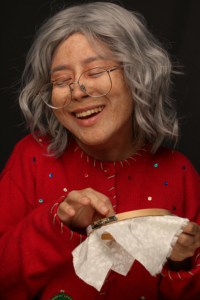
Transform Your Passion into Profession at Cinema Makeup School
Are you prepared to transform your SFX makeup skills and push your creativity further? At Cinema Makeup School, backed by Cinema Art College Corporation, you’ll learn from top industry professionals, gain hands-on experience and master the techniques that will set you apart in the SFX makeup industry.
Why Us?
- Expert instructors with real-world experience in top films and TV.
- Hands-on training with professional-grade tools and materials.
- Build an impressive portfolio showcasing your best work, giving you the edge in auditions and job opportunities.
- Financial assistance is available to help make your education more affordable.
So, what are you waiting for? Grab your brushes and tools, because you’re about to dive into the art of special effects makeup – where transformation happens, one detail at a time!
Related Articles –
How Cinema Makeup School’s Bootcamps and Workshops Empower You to Master SFX Makeup?
How to Avoid Common SFX Makeup Mistakes?
SFX vs Prosthetic Makeup: What is the Difference?
Incorporating special effects techniques to create aging makeup is a powerful way to bring realism and depth to your characters. Embrace the artistry of old age makeup and let your creativity shine through every detail!
When it comes to movie magic, special effects makeup has always been the secret weapon behind the most memorable characters on screen. From grotesque monsters to out-of-this-world aliens, SFX artists have relied on hands-on sculpting to bring the unimaginable to life. But here’s the thing: the game is changing.
Welcome to the era of 3D printed prosthetics!
Gone are the days when makeup artists had to spend hours meticulously sculpting prosthetic pieces by hand – though that’s still part of the artistry. Today, 3D printing technology is revolutionizing the way prosthetics are created, opening up new possibilities for speed, precision and creativity.
Let’s break down how this cutting-edge technology is transforming movie makeup and why it’s becoming a must-have tool for every special effects artist.
Check Out: How To Become a Makeup Artist for Films?
Evolution of Prosthetics: From Clay to Code
For years, special effects artists have relied on traditional sculpting techniques to create prosthetic pieces by hand. These hands-on methods, using clay, silicone, latex and foam – were the foundation of many iconic movie looks.
But as technology advanced, so did the tools used by SFX artists. Enter 3D modeling and 3D printing, which are reshaping the way prosthetics are designed, produced and applied on set.
What’s the secret sauce?
The combination of 3D sculpting software like ZBrush and the precision of 3D printers. ZBrush allows artists to sculpt their designs in a virtual environment, providing unparalleled detail and flexibility before a single physical piece is created.
Afterward, the design is sent to a 3D printer, which can accurately reproduce the prosthetic in high detail. The result? A more efficient, precise and versatile prosthetic creation process.

3D Sculpting in ZBrush: Real Power Behind the Prosthetics
It’s no surprise that ZBrush has become the go-to tool for SFX artists. This powerful 3D sculpting software allows artists to craft intricate details – whether it’s the folds of alien skin, the texture of a monster’s scales or the fine details on a character’s prosthetic face.
The beauty of ZBrush sculpting lies in its versatility. Artists can build their prosthetic designs from scratch, adjusting geometry, polypaint and even hair textures with incredible ease.
By using ZBrush for character sculpting, artists can create hyper realistic and fantastical designs that weren’t possible with traditional methods. Imagine sculpting intricate wrinkles, detailed veins and realistic textures, all at a digital level of precision.
That’s the magic of ZBrush sculpting and it’s exactly what makes 3D printed prosthetics so revolutionary in the movie makeup.
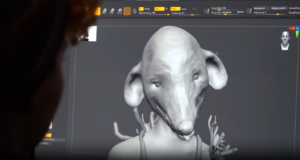
Also, read SFX vs Prosthetic Makeup: What is the Difference?
Why 3D Printed Prosthetics Are Changing Movie Makeup Forever?
So, how exactly are 3D printed prosthetics changing the industry? Let’s break it down:
1. Speed and Efficiency
In traditional prosthetic creation, sculpting, molding and casting can take days, sometimes even weeks, to perfect. With 3D printing, the entire process is streamlined.
Once the design is complete in 3D model design software, a prosthetic can be printed in a matter of hours, drastically reducing production time. This means more time for fine-tuning and getting the perfect look on set.
2. Unmatched Precision
One of the biggest advantages of 3D printed prosthetics is the level of detail they can capture. With 3D printing, every crease, texture and nuance in the design is reproduced with startling accuracy. This opens up endless possibilities for prosthetics that would have been impossible to achieve by hand.
3. Customization and Creativity
3D printing allows for complete customization. Want a prosthetic that fits a specific actor’s face? No problem. Need a set of prosthetic wings with intricate veins and textures? Done.
The flexibility of 3D printing means that prosthetics can be tailor-made for each project, allowing for more imaginative and complex designs. And since the design is digital, it can be modified quickly and easily.
4. Cost-Effective Production
While the initial investment in 3D printing technology may seem high, it’s ultimately a cost-effective solution for production studios. Its efficiency and speed save both time and money.
Additionally, 3D printers produce less waste than traditional methods, as the materials are used more efficiently and can be recycled.
See how artists work on 3D modeling software to create prosthetics:
Software Meets Sculpture: The Workflow of a Modern SFX Artist
The combination of ZBrush and 3D printing isn’t just about convenience, it’s about unlocking possibilities that were once out of reach.
- Digital Sculpting in ZBrush – This is where the magic begins. With ZBrush, artists create highly detailed digital models. They can sculpt in real-time, making modifications as they go and experiment with texture, expression & even color.
- 3D Model Design & Preparation for Printing – After the digital sculpture is complete, it’s time to prepare the file for printing. This step ensures the model is compatible with the 3D printer and that it will print in the correct proportions and dimensions. Artists can also break the model into separate pieces for easy assembly and painting once printed.
- 3D Printing & Final Touches – Now, the prosthetics are printed. The 3D printer creates each piece with amazing accuracy, capturing the smallest details. Once the prosthetic is printed, it’s cleaned, finished and painted, often with the same techniques used in traditional SFX makeup – bringing the digital design to life.
Learn How to Avoid Common SFX Makeup Mistakes?
Cinema Makeup School: Perfect Place for ZBrush Mastery
Step into the cutting-edge realm of special effects at Cinema Makeup School, a proud part of the Cinema Art College Corporation. We’re committed to shaping the next generation of SFX artists by blending traditional techniques with the latest digital innovations.
Our ZBrush Training Course doesn’t just teach you to use industry-standard tools, it empowers you to seamlessly integrate time-honored sculpting with the power of modern technology, ensuring you’re always ahead of the curve.
Embrace the future of movie makeup and let your creativity run wild. Enroll now!
FAQs
1. What Software Do Designers Use for 3D Modeling?
Designers use various software tools for 3D modeling, but the most popular and industry-standard software is ZBrush. ZBrush is widely used for its powerful digital sculpting tools, making it ideal for creating highly detailed models and intricate textures.
Other commonly used 3D modeling software includes Maya, Blender and 3ds Max, each offering unique features for different aspects of 3D design.
2. What If I Can’t Afford the Full Cost of the SFX Course?
We offer financial assistance to help make your education more affordable. Check out the details here!
3. What Makes ZBrush Different from Other 3D Modeling Software?
Unlike other 3D modeling software, ZBrush focuses on digital sculpting, offering a more intuitive approach for creating organic shapes and detailed textures. Its unique ability to handle millions of polygons lets artists create intricate designs that are perfect for special effects.
